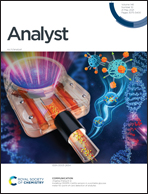Electrified liquid–liquid interface as an electrochemical tool for the sensing of putrescine and cadaverine†
Abstract
Putrescine and cadaverine are biogenic amines that serve as potential biomarkers for several types of cancers and monitoring food quality. Electrochemical sensing of putrescine and cadaverine by non-enzymatic routes remains a challenge because of their inertness at unmodified electrode surfaces and hence a liquid–liquid interface strategy has been employed for their detection. In the present study, electrochemical sensing of cadaverine and putrescine has been demonstrated by simple and facilitated ion-transfer processes using a liquid–liquid microinterface supported by a microcapillary. A microinterface was constructed in different configurations by varying the aqueous phase composition in the absence and presence of dibenzo-18-crown-6, and the ion-transfer ability of putrescine and cadaverine was studied in these configurations. A peak shaped voltammogram was observed in the backward scan, due to the linear diffusion of putrescine and cadaverine from the organic to the aqueous phase. The detection ability in the presence of dibenzo-18-crown-6 was observed in the concentration ranges of 0.25–25 μM and 0.25–40 μM for putrescine and cadaverine with detection limits of 0.11 and 0.17 μM respectively. In the presence of dibenzo-18-crown-6, the electrochemical sensing of putrescine and cadaverine was more pronounced compared to the simple ion-transfer process.



 Please wait while we load your content...
Please wait while we load your content...